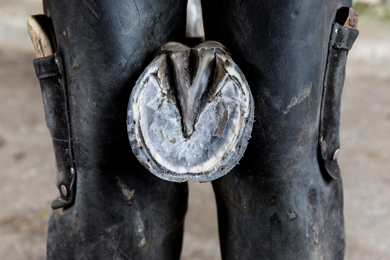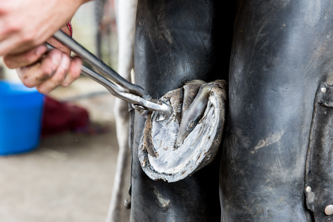Monday night saw the first of three webinars as part of the BHS February Foot Focus series ran in conjunction with the British Farriers and Blacksmiths Association (BFBA). Hosted by Erik Mackechnie-Guire Fellow of the BHS - the evening was a sell out with 1000 people tuning in to watch live.
Regulation and the law
The evening began with Erik introducing David Greenwood – a registrar for the Farriers Registration Council (FRC). David gave great insight into the benefits of using a registered farrier for all aspects of hoof trimming and shoeing, explaining the regulatory bodies and laws which protect customers and their horses. Vets, vet nurses and farriers are all subject to statutory regulation which other allied-professionals fall outside of, although they may be part of voluntary regulatory schemes.
David shared some quick maths to outline the vast training which farriers go through as a minimum to become qualified. An apprentice will typically spend four years in training which includes both theoretical knowledge in college and practical skills with an approved training farrier (ATF). An apprentice will complete 3684 trims/shoeings throughout their training career! This is based on the apprentices completing three days per week to see six horses – so the real figure is likely to be much higher!
Here's the key message from David: “My pitch to you is that if you want assured service to a high standard and peace of mind for the horse owner, you would certainly wish to give very clear consideration to employing a registered farrier as your trimmer and shoer of first choice.”
Anatomy and mechanisms
Mark Trussler Fellow of the Worshipful Company of Farriers (FWCF) and examiner for the WCF talked through the anatomy of the hoof and mechanical components. Introducing three foot loading theories: compression, depression and haemodynamic flow theory. These are all crucial into better understanding the research into how the hoof works and deciding on whether to shoe or not. Mark got everybody to grips with the considerations owners need to think about before taking their horse’s shoes off. Topics such as the type and level of work, terrain where the horse lives and works, conformation and pre-existing conditions such as laminitis were discussed.
The takeaway from Mark’s presentation was to consider all the above-mentioned points before transitioning to barefoot. Owners should also consider whether they can provide the changes of management and the time to allow the horse to successfully transition to barefoot.
“Ask yourself why you want your horse to go barefoot. People don't often have the luxury of time to allow the hooves to change - they need to be trimmed regularly and correctly and to allow that strengthening to happen. And what do you do if your horse goes lame? What is your plan B?”

Equipment and welfare
Sarah Logie FWCF was the final speaker of the evening. Sarah’s initial discussion encouraged people to think about the general equipment which we have and use – most of which the horse would not be interested in (things such as a new rug or a training aid). These pieces of equipment are used to make owners lives easier or to improve the horse’s welfare, which is the view Sarah holds regarding shoes.
The horse’s welfare is the first and foremost priority and all the considerations Mark mentioned, she agreed, are extremely important. Sarah added that if you’re considering taking shoes off your horse, it needs to be done in a sympathetic manner which doesn’t leave them in discomfort.
Sarah provided a great case study of a horse and owner which she’s worked closely with. The horse was barefoot but needed shoes to overcome a condition - once recovered, the horse reverted back to being successfully barefoot. Sarah consistently emphasised the need to prioritise the horse’s welfare above all else. Each horse and circumstance are individual and should be treated in this way.

“I can help a horse cope with their conformation, cope better with their environment, cope better with their job but still looking after that foot, respecting the horn growth, respecting it’s anatomy is the most important thing of what I do. Whether I then protect it with a shoe, or advise a boot, or say you need nothing is up to the individual circumstances.”
A question-and-answer session followed on from the huge amount of experience and knowledge demonstrated by the presenters. Questions regarding regulation and the FRC were put forwards, along with questions regarding materials, types of shoe and the pros and cons of shod and barefoot horses were all discussed. A huge thank you to Erik, David, Mark and Sarah for a thought provoking and interesting discussion.
To watch the webinar back in full visit here
On Monday 13 February, Erik will be welcoming two more speakers, Mark Johnson and Sarah Brown to discuss how to keep your horses’ feet in great shape. To join the conversation please sign up by visiting our ticketing partner here
Get in touch – we’re here to help
The BHS Horse Care and Welfare Team are here to help and can offer you further advice with any questions you may have. Contact us on 02476 840517* or email welfare@bhs.org.uk – You can also get in touch with us via our social media channels.
Opening times are 8:35am - 5pm from Monday – Thursday and 8:35am - 3pm on Friday.
*Calls may be recorded for monitoring purposes.

